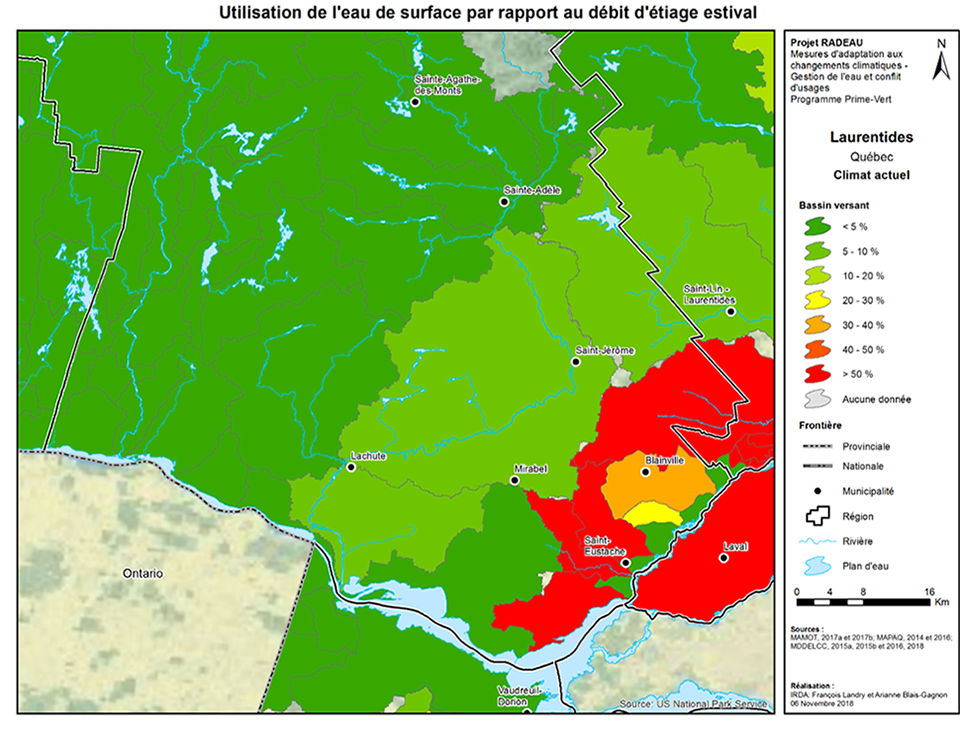Participative Research on Sustainable Alternatives for Water Management in Agricultural Areas in the Context of Climate Change
The RADEAU 1 and 2 projects exploited and structured the large quantity of existing data and developed new data in order to characterize the water balance of the regions under study in current and future climates, and thus help inform the government, regional actors and other studies on water management.
Project details
Principal(s) investigator(s)

Context
Climate change is expected to have a major impact on the availability of water and the maintenance of its quality for various uses in Québec. It is therefore important to work with local water management stakeholders to identify the risks of conflicts related to climate change and to analyze appropriate adaptation strategies.
Objective(s)
-
Support the acquisition, synthesis and sharing of knowledge on the current and future water consumption and availability situation in five agricultural regions: Montérégie, Estrie, Chaudière-Appalaches, Lanaudière and Centre-du-Québec;
-
Assess the adaptive capacity of agricultural enterprises to cope with water supply conflicts in the regions under study
Methodology
The implementation of the project will be based on a participative approach involving stakeholders from the agricultural regions concerned, combined with knowledge resulting from applied hydrology research
-
Produce regional assessment reports linking water availability and needs in different activity sectors (agriculture, industry, domestic/urban) under the present climate and over the 2050 time horizon (by exploiting available data and modelling crop water needs);
-
Further analyze selected vulnerable target areas in more detail through the development of a meta-model of water availability and needs;
-
Identify existing and potential avenues for adaptation through expert consultations and a literature review;
-
Assess individual and collective management practices for avoiding water use conflicts in different regions (participative approach with local actors and evaluation of the effectiveness of selected actions using the meta-model developed above).
Results
In the 11 regions studied, the general picture of water availabilities and needs of different users in current and future climates (Figure 1) led to a number of observations.
Currently, the dominant sources of water for meeting agricultural needs vary from region to region. For example, groundwater accounts for 93% and 90% of agricultural non-fish farming use in the Outaouais and Bas-St-Laurent respectively and only 30% in Laval and 40% in the Capitale-Nationale region.
While in some regions studied, agricultural uses represent a relatively large share of total withdrawals (e.g., 34% in Centre-du-Québec, 26% in Chaudière-Appalaches, 24% in Bas St-Laurent and 14% in Mauricie), they represent only 1% to 6% of total withdrawals in other regions. The agricultural sector must certainly contribute to efforts to use water more responsibly, but it is not necessarily the sector that exerts the most pressure on water resources. Demographics are often the deciding factor.
Water use conflicts observed in the past have mainly involved residential and ICI (Institutional, Commercial and Industrial) uses. However, it would appear that conflicts between the residential and agricultural sectors for the use of potable water are more frequent.
The practice of irrigation has been increasing over the past decade, and water quality programs such as Canada GAP impose high standards of irrigation water quality on fruit and vegetable growers. Thus, the use of groundwater is particularly high in relation to available resources in Montérégie-Ouest, where the water needs of residential and industrial users are significant and growing, and where there is a pool of fruit and vegetable growers whose withdrawals for crop irrigation are significant.
The L’Assomption River and Mascouche River watersheds in Lanaudière are other examples where withdrawals for residential, ICI and agricultural uses are putting pressure on surface water resources.

Figure 1. Map projection of the Laurentian region showing current surface water use relative to summer low flow. Pressure indices highlight the vulnerability of areas in the southern part of the region around the Milles-Îles River and other minor watercourses, where the critical threshold of 15% has been exceeded.
In addition, four case studies were carried out on smaller areas: the Lanoraie peatland complex in Lanaudière, where more than 3,000 ha of potatoes, irrigated with water from surface aquifers, are at risk if the level of the water table continues to drop, the Ruisseau Rousse in the Laurentians where surface water will have difficulty meeting the needs of agricultural producers for crop irrigation in future climates, and the MRC de Portneuf and Saint-Rémi in Montérégie.
These case studies have shown the importance of basing decision-making on the collection and analysis of data on water needs and resources at sufficiently fine scales. While it may be relevant in some situations to analyze alternative water source options or collective water management solutions to secure access to water resources, the study has mainly shown that there is room for improvement in agricultural water use efficiency (optimization of equipment and irrigation regimes) and growing practices and systems (e.g., the optimal choice of strawberry and potato cultivars)
Benefits for adaptation
Benefits for adaptation
Exploited and structured the large quantity of existing data and developed new data (e.g., water consumption charts for the main types of crop and livestock production in Québec) in order to characterize the water balance of the regions under study in current and future climates, and thus help inform the government, regional actors and other studies on water management.
Proposed recommendations for the development of intervention strategies to mitigate or avoid water use conflicts intended for Québec’s agricultural sector (e.g., educating agricultural producers and stakeholders about water management regulations) or the targeted case studies.
Scientific publications
Funding

La contribution d’Ouranos dans ce projet est sous forme d’expertise
Ce projet est réalisé en vertu du sous-volet 3.2 du programme Prime-Vert 2013-2018 et il a bénéficié d’une aide financière du ministère de l’Agriculture, des Pêcheries et de l’Alimentation (MAPAQ) et du Plan d’action 2013-2020 sur les changements climatiques (PACC 2013-2020)
Other participants
-
Sylvestre Delmotte, consultant
-
Institut de recherche et de développement en agroenvironnement (IRDA)
-
Université Laval
-
Agriculture et Agroalimentaire Canada (AAC)
-
Direction de l’expertise hydrique (DEH)
-
INRS-ÉTÉ